Thomas Jefferson, like others of his day, was a patron and admirer of the fine arts, which were “fine” because they were autotelic—viz., enjoyed as ends in themselves.
The number of the Fine Arts was a matter of debate in his day. To granddaughter Ellen Wayles Randolph (10 July 1805), President Jefferson writes:
I must observe that neither the number of the fine arts, nor the particular arts entitled to that appellation have been fixed by general consent. many reckon but five Painting, sculpture, architecture, music & poetry. to these some have added Oratory, including, within that, Rhetoric which is the art of style & composition. others again, add Gardening as a 7th. fine art. not horticulture, but the art of embellishing grounds by fancy. I think Ld. Kaims has justly proved this to be entitled to the appellation of a fine art. it is nearly allied to landscape painting, & accordingly we generally find the landscape painter the best designer of a garden. no perfect definition of what is a fine art has ever yet been given. some say that as those are mechanical arts, which consist in manual operation unconnected with the understanding, those are fine arts which to manual operation join the exercise of the imagination or genius. this would comprehend sculpture, painting, architecture & gardening, but neither music, poetry, nor oratory. others say that the sciences are objects of the understanding, the fine arts of the senses. this would add gardening, but neither poetry nor oratory. a definition which should include Poetry & Oratory & no more would be very difficult to form.
Yet Jefferson did settle on eight fine arts—nine if one includes criticism, which is a sort of meta-fine art, as it sits in verbal judgment of the other fine arts—and he divided them into Belles Lettres, essentially using words, and Beaux Arts, not requiring words.
Belles Lettres Beaux Arts
criticism architecture
oratory gardening
poetry music
rhetoric painting
sculpture
Ever a pragmatist of sorts, Jefferson aimed to put to use beauty—that is, he considered that beauty to be most beautiful that was serviceable for human ends. That is why architecture was his favorite fine art. It typically aimed chiefly at functionality and only secondly at beauty. Yet when Jefferson designed buildings, beauty and functionality were confluent ends.
Of the two branches of fine arts, Jefferson was more attracted to Beaux Arts than to Belles Lettres. That might come as a large surprise, given Jefferson’s artistry with his quill: e.g., Declaration of Independence and First Inaugural Address. Yet he was a skilled violinist till he broke his right wrist in 1786, a knowledgeable farmer, and perhaps the greatest early American architect, if we follow the lead of architectural historian Fiske Kimball. Yet husbandry was not gardening, for the former aimed only at yield, while the latter, only at beauty. Architecture too was not gardening, for only the latter was essentially beautification by use of living things. Still, Jefferson’s love of architecture required a love of gardening, for no significant structure could be placed in any random natural landscape and every significant building needed to be embellished by flora.
Jefferson’s views on landscape gardening contrasted much with his views on architecture. In architecture, Jefferson usually expressed buckram—a sort of stiff formality through strict adherence to geometric patterns and arithmetic ratios dictated by Palladian (neo-Classical) standards, derived from Vitruvian antiquity. When it came to pleasure gardens, however, he inclined not to the strict geometric patterns that predominated in many French pleasure gardens, but to the relatively relaxed and flowing patterns of the modern English gardens, following nature, of his day. By following nature, he was guided by Thomas Whately, who said in Observations on Modern Gardening: “Architecture requires symmetry; the object of nature freedom; and the properties of the one, cannot be with justice transferred to the other.”
Those patterns were dictated much by philosophers William Hogarth, Edmund Burke, and Lord Kames. Burke publishes A Philosophical Enquiry into the Origin of Our Ideas of the Sublime and Beautiful (1756). He maintains that “another principal property of beautiful objects is that the line of their parts is continually varying.” Kames years later publishes Elements of Criticism (1762) and argues that beauty, following nature, takes a middle path between uniformity and variety. Hogarth publishes The Analysis of Beauty in 1770 and argues that winding lines are essential for beauty. “There is scarce an Egyptian, Greek, or Roman deity, but hath a twisted serpent, twisted cornucopia, or some symbol winding in this manner to accompany it.” His view of the beauty of winding lines was popular in Jefferson’s day and was much put to use in crafting Jefferson’s gardens.
Upon retirement from the presidency, Jefferson grappled with two significant gardening aims: to make all the land on which Monticello sat an enormous pleasure garden and to place around Monticello several distinct pleasure-garden beds. I seriatim discuss each.
First, any gentleman farmer or Southern planter could make his entire estate a garden. As Philip Southcote, designer of an estate at Woburn in Surrey, England, says, “Why may not a whole estate be thrown into a kind of Garden? If the natural Embroidery of the meadows were [sic] Additions of Art, and the several rows of Hedges set off by Trees and flowers, a man might make a pretty landskip of his own Possessions.” Jefferson, who visits Woburn while touring the gardens of England with Adams, writes coolly of its gardens in his notes on English pleasure gardens: “Four people to the farm, four to the pleasure garden, four to the kitchen garden. All are intermixed, the pleasure garden being merely a highly-ornamented walk through and round the divisions of the highly ornamented garden.”
Sketches he made while president indicate that Jefferson aimed at an admixture of beauty and functionality at Monticello—to make the whole estate a garden—by creation of walkways, “roundabouts” (Figure 1), around his farmed lots—thereby making a garden of his estate. There were four roundabouts. In his Garden Book (23 Oct. 1778), Jefferson says that the roundabout from Monticello’s door to “the stone flood mark of 1778 by the river” is 1.5124 miles, “from the head of the Canal along my private road into public road by Shadwell thence down public road to where the mill road will come in” is 1.0426 miles, and “from the head of the Canal down the same to walnut where mill house will stand thence down the mill road along river side to Chapel branch thence up Chapel branch as the mill road is to be into the public road” is 1.5113 miles. His measurements came from a survey “with a chain very exact.” Decades later (1808), he writes in a note to overseer Francis Bacon, “In the open grounds on both the 3d. and 4th Roundabouts lay off lots for the minor articles of husbandry for experimental culture, disposing them into a ferme ornée [ornamental farm] and by interspersing occasionally the attributes of a garden.”
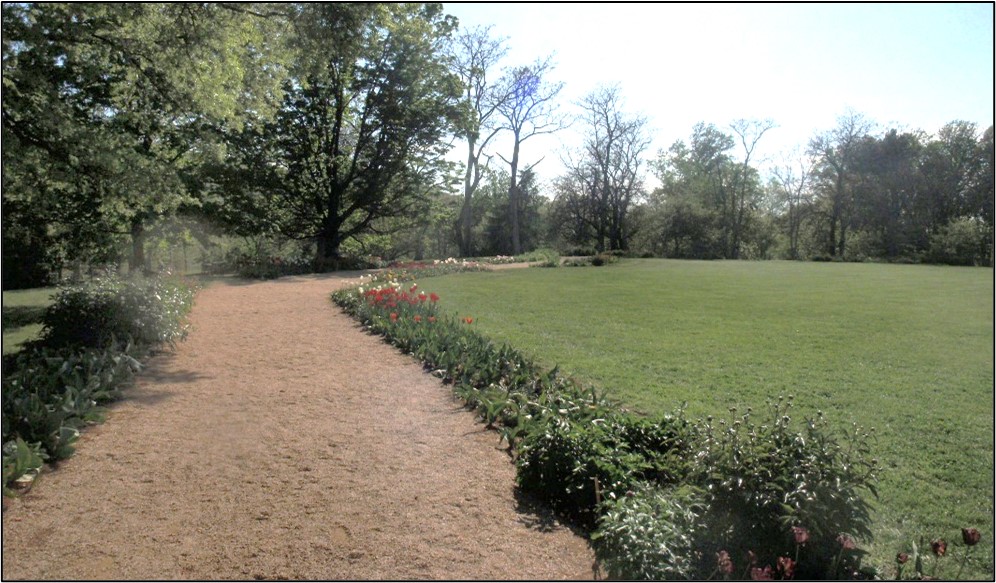
Jefferson grappled with beautification of his lands at Monticello. As early as 1771, he wrote up a plan in his Account Book for elaborates on an account for the site of “a burying place” for “an unfrequented vale in the park” where there are “antient and venerable oaks.” A certain Isaac Weld, Jr., who visits Monticello in May 1796, says, “The mountain whereon the house stands is thickly wooded on one side, and walks are carried round it, with different degrees of obliquity, running into each other.” That comes out especially in a letter William Hailton (31 July 1806), a disciple of landscape architect George Parkyns, who published Six Designs in 1793. In the letter, Jefferson writes of improving certain native-woods grounds, “which are in a form very difficult to manage,” to be done “in the style of the English gardens.”
they compose the Northern quadrant of a mountain for about ⅔ of it’s height, & then spread for the upper third over it’s whole crown. they contain about 300. acres, washed at the foot, for about a mile, by a river of the size of the Schuylkill. the hill is generally too steep for direct ascent, but we make level walks successively along on it’s side, which in it’s upper part encircle the hill, & we intersect these again by others of easy ascent in various parts. they are chiefly still in their native woods, which are majestic, and very generally, a close undergrowth, which I have not suffered to be touched, knowing how much easier it is to cut away, than to fill up. the upper third is chiefly open, but to the South is covered with a dense thicket of Scotch broom (Cerastium supparium Lin.) which being favorably spread before the sun will admit of adventageous [sic] arrangement for winter enjoyment. you are sensible that this disposition of ground takes from me the first beauty in gardening, the variety of hill & dale, & leaves me as an awkward substitute a few hanging hollows & ridges. this subject is so original unique & at the same time refractory that to make a disposn analogous to it’s character, would require much more of the genius of the landscape painter & gardener than I pretend to.
The idea was to create a sort of ornamental forest, a grove, on the northern side of the monticule by cutting away, not filling up. Instead of clearing and grubbing a spot of land and then creating a garden through planting vegetation according to discretion, one begins with a densely wooded area and then removes, thins, trims, and prunes to create a wooded garden, pursuant to aesthetic taste, from what is already there. And so, Jefferson at Monticello would remove understory, trim trees, and eliminate unsightly copse and do so “in the style of the English gardens.”
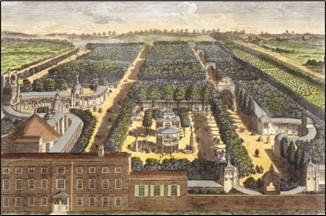
During his stint as minister plenipotentiary from 1784 to 1789 in France, Jefferson thrice traveled to England. On one trip, he and John Adams toured the pleasure gardens of England (e.g., Vauxhall, Figure 2) and Jefferson recorded his impressions of gardens at Chiswick, Hampton Court, Twickenham Esher Place, Claremont, Paynshill, Woburn, Caversham, Wottom, Stowe, Leasowes, Hagley, Blenheim, Enfield Chase, Moor Park, and Kew. He took with him Thomas Whately’s Observations on Modern Gardening—an immensely popular book in Jefferson’s day—because Whately had much to say about some of the gardens he would see. He begins his book with this prolix passage. Prolixity was typical of the time.
Gardening, in the perfection to which it has been lately brought in England, is entitled to a place of considerable rank amount the liberal arts. It is as superior to landskip painting, as a reality to a representation: it is an exertion of fancy; a subject for taste; and being released now from the restraints of regularity, and enlarged beyond the purposes of domestic convenience, the most beautiful, the most simple, the most noble scenes of nature are all within its province: for it is no longer confined to the spots from which it borrows its name, but regulates also the disposition and embellishments of a park, a farm, or a riding; and the business of a gardener is to select and to apply whatever is great, elegant, or characteristic in any of them; to discover and to shew all the advantages of the place upon which he is employed; to supply its defects, to correct its faults, and to improve its beauties.
Jefferson’s tour of the gardens, as was the case with his study of buildings he saw in France and England, was for the sake of transporting what was useful and beautiful back to America, and to be placed on display at Monticello.
English models, he continues to Hamilton, are problematic, because the climate is much different. “their sun-less climate has permitted them to adopt what is certainly a beauty of the very first order in landscape. their canvas is of open ground, variegated with clumps of trees distributed with taste. they need no more of wood than will serve to embrace a lawn or a glade.” Virginia is dissimilar. “under the beaming, constant & almost vertical sun of Virga, shade is our Elysium. in the absence of this no beauty of the eye can be enjoyed. this organ then must yield it’s gratificn to that of the other senses, without the hope of any equivalent to the beauty relinquished.”
Jefferson, however, is undaunted by the enormousness of the task. Because of the heat of the unrelenting sun, most trees must remain, yet they can be trimmed “as high as the constitution & form of the tree will bear, but so as that their tops shall still unite and yield a dense shade.” He adds:
a wood, so open below, will have nearly the appearance of open grounds. then, where in open ground you would plant a clump of trees, place a thicket of shrubs presenting a hemisphere, the crown of which shall distinctly show itself under the branches of the trees. this may be effected by a due selection & arrangement of the shrubs, and will I think offer a groupe not much inferior to that of trees. the thickets may be varied too by making some of them of evergreens, altogether. our red cedar made to grow in a bush, ever green Privet, Hyacanthus, Kalmia, Scotch broom.
The view, he imagines, would be spectacularly panoramic—a happy admixture of sublimity and beauty.
Of prospect I have a rich profusion and offering itself at every point of the compass, mountains distant & near, smooth & shaggy, single & in ridges, a little river hiding itself among the hills so as to shew in lagoons only, cultivated grounds, under the eye and two small villages. to prevent a satiety of this is the principal difficulty. it may be successively offered, & in separate different portions through vistas, or which will be better, between thickets so disposed as to serve for vistas, with the advantage of shifting the scenes as you advance on your way.
We do not know the extent to which Jefferson began and completed the project of creating a grove.
Second, Jefferson undertook the project of installing oval beds of flowers to enhance the beauty of Monticello and to pander to his beloved granddaughters. Jefferson in the spring of 1807, drew up 20 floral beds to bedeck Monticello. They were laid out on April 11 and by April 13, were planted with trees, shrubs, and flowers—many of which he got from Bernard McMahon, author of The American Gardener’s Calendar. Thirteen paper mulberries, six hotrse chestnuts, two tacamahac poplars, four purple beeches, two robinias, two chokecherries, three mountain ashes, two zanthoxylums, one redbud, one fraxinella, and two guelder roses were planted in the circular beds at the corners of the residence. The oval beds were festooned with numerous types of flowers from China pink, yellow-horned poppies, and dianthuses to single carnations, yellow lillies, glaucia, and Jeffersonia diphylla. The last, commonly called Twinleaf (Figure 3) was named after Jefferson on account of horticulturalist Benjamin Smith Barton. In a paper to the American Philosophical Society (18 May 1792), Barton said: “In imposing upon this genus the name of Mr. Jefferson, I have had no reference to his political character, or to his repuation for general science and for literature. My business was with his knowledge of natural history. In the various departments of this science, but especially in botany and zoology, the information of this gentleman is equalled by that of few persons in the Unites States.”
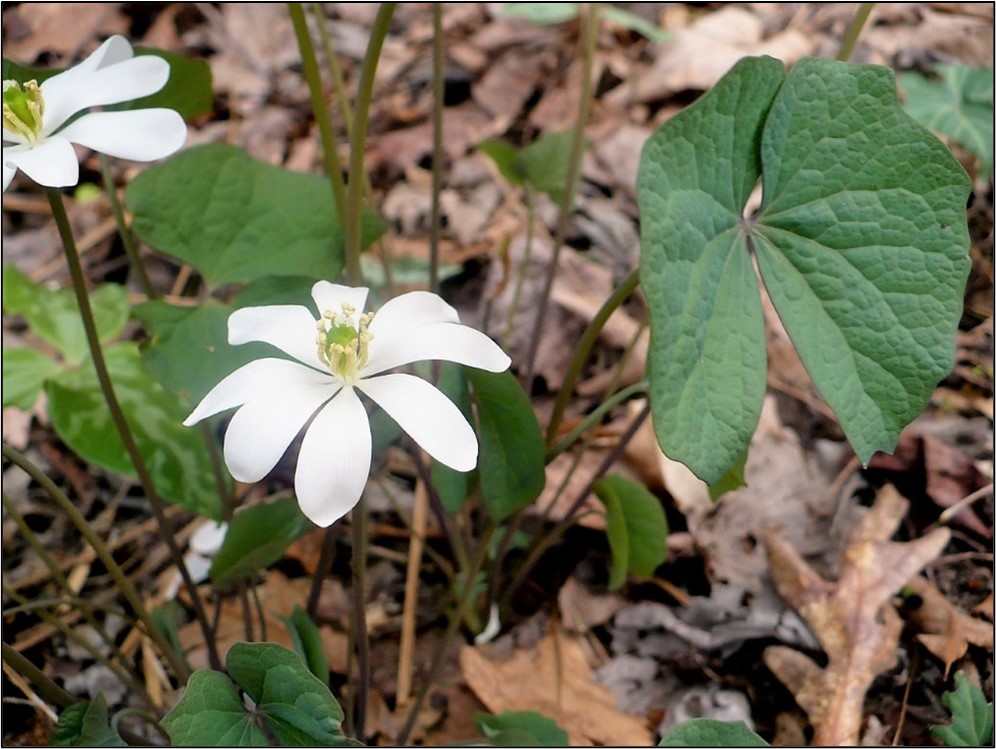
To accent the oval beds, he put in a winding walkway—following Hogarth and the current English vogue, he preferred ambages to straight walkways—on the West Lawn of Monticello. To granddaughter Anne Cary Randolph (7 June 1807), Jefferson writes: “I find that the limited number of our flower beds will too much restrain the variety of flowers in which we might wish to indulge, & therefore I have resumed an idea, which I had formerly entertained, but had laid by, of a winding walk surrounding the lawn before the house, with a narrow border of flowers on each side. this would give us abundant room for a great variety.” The walkway was implemented in spring 1808.
Jefferson’s daughter and granddaughters, often under the direction of slave Wormly Hughes, or Jefferson, would upkeep the flower gardens, each 10-foot bed featuring a different flower.
Jefferson was decidedly an anthophile—a lover of flowers. “Of flowers … he was very fond,” writes granddaughter Ellen Randolph Coolidge. She continues: “I remember the planting of the first hyacinths and tulips, and their subsequent growth. The roots arrived, labelled each one with a fancy name. There was [sic] Marcus Aurelius, and the King of the Gold Mine, the Roman Empress, and the Queen of the Amazons, Psyche, God of Love.” She and her sisters then waited for spring. “What joy it was for one of us to discover the tender green breaking through the mould, and run to grandpapa to announce, that we really believed Marcus Aurelius was coming up, or the Queen of the Amazons was above ground!” The letter, characteristic of many other writings on Jefferson by his grandchildren, betrays profundity of love by them for him.
I end with some thoughts on Jefferson and trees.
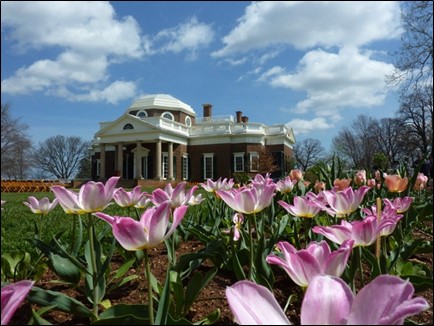
Jefferson planted and groomed Monticello’s trees to define its landscape. In 1769, he created the first orchard—comprising pomegranate, apple, nectarines cherry, pear, peach, apricot, almond and fig trees—on the southeast slope of the monticule. He had some 160 types of trees, some native and some foreign, which he often aimed to put to both practical (food or shade) and ornamental use. Trees were native and exotic: e.g., ornamental trees were near the mansion and peach-tree fences bordered his fields. Margaret Bayard Smith recalls a sentiment of Jefferson in a dinner engagement with him in Washington, D.C., that betrays Jefferson large love of trees. “I wish I was a despot that I might save the noble, beautiful trees that are daily falling sacrifice to the cupidity of their owners, or the necessity of the poor. … The unnecessary felling of a tree, perhaps the growth of centuries, seems to me a crime little short of murder.”




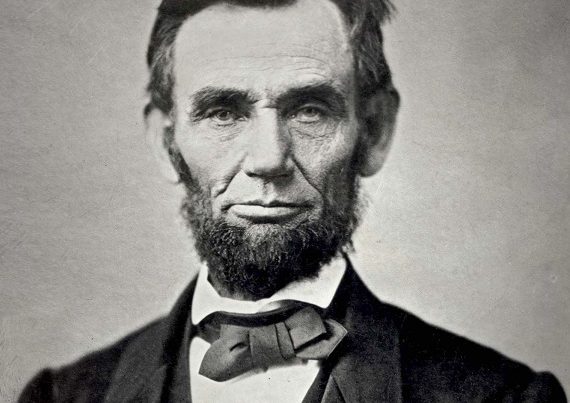

You can grow more food in your yard than you can imagine. The only thing you can’t eat in my yard is the grass.